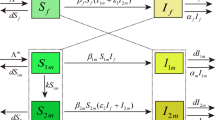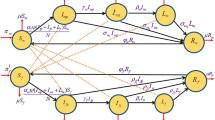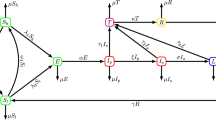Abstract
We establish a mathematical model to analyze what factors cause the epidemics of sexually transmitted diseases (STDs) and how to eliminate or mitigate them. According to the level of prevention awareness, we divide the susceptible population into two groups of individuals, whose behavior, population size, and recruitment rate are affected by the interventions. First, the threshold, \(R_0\), of STDs model is obtained. If \(R_0 < 1\), the disease-free equilibrium is globally asymptotically stable. We also obtain the conditions for switching the equilibrium state of the model among disease-free equilibrium, endemic equilibrium, and limit cycle. Second, the threshold and transcritical bifurcation show that interventions for high-risk sexual behaviors of high-risk susceptible individuals can eliminate STDs. Additionally, sex education, influenced by the size of infected individuals and by interventions, can effectively cut down the size of STDs. Third, extending the survival time of the infected individual may prolong the time to end STDs unless they reject high-risk sexual behavior. Fourth, we analyze the existence, stability, and direction of Hopf bifurcation, which may explain the periodic oscillation in the size of infected population.








Similar content being viewed by others
References
WHO TEAM, Global health sector strategies on, respectively, HIV, viral hepatitis and sexually transmitted infections for the period 2022–2030
Seidu, A.-A., Darteh, E.K.M., Kumi-Kyereme, A., Dickson, K.S., Ahinkorah, B.O.: Paid sex among men in sub-Saharan Africa: analysis of the demographic and health survey. SSM-Popul. Health 11, 100459 (2020)
Song, Y., Ji, C.-Y.: Sexual intercourse and high-risk sexual behaviours among a national sample of urban adolescents in China. J. Public Health 32(3), 312–321 (2010)
Goldfarb, E.S., Lieberman, L.D.: Three decades of research: the case for comprehensive sex education. J. Adolesc. Health 68(1), 13–27 (2021)
Lindberg, L.D., Kantor, L.M.: Adolescents’ receipt of sex education in a nationally representative sample, 2011–2019. J. Adolesc. Health 70(2), 290–297 (2022)
Li, G., Jiang, Y., Zhang, L.: HIV upsurge in China’s students. Science 364(6442), 711 (2019)
Starkman, N., Rajani, N.: The case for comprehensive sex education. AIDS Patient Care STDS 16(7), 313–318 (2002)
Bauch, C.T.: Imitation dynamics predict vaccinating behaviour. Proc. R. Soc. B Biol. Sci. 272(1573), 1669–1675 (2005)
Pharaon, J., Bauch, C.T.: The influence of social behaviour on competition between virulent pathogen strains. J. Theor. Biol. 455, 47–53 (2018)
Levin, S.A., Hallam, T.G., Gross, L.J.: Applied Mathematical Ecology, vol. 18. Springer, Berlin (2012)
National Center for AIDS/STD Control and Prevention, China CDC. https://www.chinaaids.cn/qsnazbfk/sdgz/201702/t20170224_138582.htm. Accessed 15 Oct 2022 (2022)
Centers for Disease Control and Prevention. https://www.cdc.gov/std/life-stages-populations/adolescents-youngadults.htm. Accessed 13 Oct 2022 (2022)
Aral, S.O.: Sexually transmitted diseases: magnitude, determinants and consequences. Int. J. STD AIDS 12(4), 211–215 (2001)
Gao, S., Martcheva, M., Miao, H., Rong, L.: A dynamic model to assess human papillomavirus vaccination strategies in a heterosexual population combined with men who have sex with men. Bull. Math. Biol. 83, 1–36 (2021)
Ghosh, I., Tiwari, P.K., Samanta, S., Elmojtaba, I.M., Al-Salti, N., Chattopadhyay, J.: A simple SI-type model for HIV/AIDS with media and self-imposed psychological fear. Math. Biosci. 306, 160–169 (2018)
Sagar, V., Zhao, Y.: Collective effect of personal behavior induced preventive measures and differential rate of transmission on spread of epidemics. Chaos Interdiscip. J. Nonlinear Sci. 27(2), 023115 (2017)
Wang, K., Zhao, H., Wang, H.: Traveling waves for a diffusive mosquito-borne epidemic model with general incidence. Z. Angew. Math. Phys. 73(1), 31 (2022)
Ma, Z.: Dynamical Modeling and Analysis of Epidemics. World Scientific, Singapore (2009)
Lakshmikantham, V., Leela, S., Martynyuk, A.A.: Stability Analysis of Nonlinear Systems. Springer, Berlin (1989)
Yang, R., Wang, F., Jin, D.: Spatially inhomogeneous bifurcating periodic solutions induced by nonlocal competition in a predator-prey system with additional food. Math. Methods Appl. Sci. 45(16), 9967–9978 (2022)
Van den Driessche, P., Watmough, J.: Reproduction numbers and sub-threshold endemic equilibria for compartmental models of disease transmission. Math. Biosci. 180(1–2), 29–48 (2002)
Carr, J.: Applications of Centre Manifold Theory, vol. 35. Springer, Berlin (2012)
Ye, Y., Zhao, Y.: Bifurcation analysis of a delay-induced predator-prey model with Allee effect and prey group defense. Int. J. Bifurc. Chaos 31(10), 2150158 (2021)
Xiang, C., Huang, J., Wang, H.: Linking bifurcation analysis of Holling–Tanner model with generalist predator to a changing environment. Stud. Appl. Math
Yuan, P., Zhu, H.: The nilpotent bifurcations in a model for generalist predatory mite and pest leafhopper with stage structure. J. Differ. Equ. 321, 99–129 (2022)
Zhou, J., Zhao, Y., Ye, Y., Bao, Y.: Bifurcation analysis of a fractional-order simplicial SIRS system induced by double delays. Int. J. Bifurc. Chaos 32(05), 2250068 (2022)
Lawrence, P.: Differential Equations and Dynamical Systems. Springer, New York (1991)
Castillo-Chavez, C., Song, B.: Dynamical models of tuberculosis and their applications. Math. Biosci. Eng. 1(2), 361 (2004)
Wiggins, S.: Introduction to Applied Nonlinear Dynamical Systems and Chaos. Springer, Berlin (2003)
Jiang, J., Liang, F., Wu, W., Huang, S.: On the first Liapunov coefficient formula of 3D Lotka-Volterra equations with applications to multiplicity of limit cycles. J. Differ. Equ. 284, 183–218 (2021)
Yang, R., Nie, C., Jin, D.: Spatiotemporal dynamics induced by nonlocal competition in a diffusive predator-prey system with habitat complexity. Nonlinear Dyn. 110(1), 879–900 (2022)
World Health Organization. https://www.who.int/news-room/feature-stories/detail/four-curable-sexually-transmitted-infections---all-you-need-to-know. Accessed 20 Oct 2022 (2019)
Wu, Z., Chen, J., Scott, S.R., McGoogan, J.M.: History of the HIV epidemic in China. Curr. HIV/AIDS Rep. 16, 458–466 (2019)
Chinese Centers for Disease Control and Prevention. https://www.chinacdc.cn/jkzt/sthd_3844/slhd_12884/202203/t20220323_257909.html. Accessed 5 Oct 2022 (2022)
Coates, T.J., Richter, L., Caceres, C.: Behavioural strategies to reduce HIV transmission: how to make them work better. Lancet 372(9639), 669–684 (2008)
Ajayi, A.I., Ismail, K.O., Akpan, W.: Factors associated with consistent condom use: a cross-sectional survey of two Nigerian universities. BMC Public Health 19(1), 1–11 (2019)
Hyman, J.M., Stanley, E.A.: Using mathematical models to understand the AIDS epidemic. Math. Biosci. 90(1–2), 415–473 (1988)
Wang, C.-L., Gao, S., Li, X.-Z., Martcheva, M.: Modeling syphilis and HIV coinfection: a case study in the USA. Bull. Math. Biol. 85(3), 20 (2023)
Zhang, J., Hao, W., Jin, Z.: The dynamics of sexually transmitted diseases with men who have sex with men. J. Math. Biol. 84, 1–25 (2022)
Deng, Q., Guo, T., Qiu, Z., Chen, Y.: Towards a new combination therapy with vectored immunoprophylaxis for HIV: modeling “shock and kill’’ strategy. Math. Biosci. 355, 108954 (2023)
Chinese Centers for Disease Control and Prevention. http://www.nhc.gov.cn/jkj/s3578/202208/f470f0abf544436d901c2660b06f3911.shtml. Accessed 4 Oct 2022 (2022)
Murray, J.D.: Mathematical Biology. Springer, Berlin (1998)
Acknowledgements
LX is funded by the National Natural Science Foundation of China 12171116 and Fundamental Research Funds for the Central Universities of China 3072020CFT2402 and 3072022TS2404. XL is funded by the National Natural Science Foundation of China 12271143. We thank Dr. Hao Wang for the valuable discussion.
Author information
Authors and Affiliations
Contributions
KZ and LX investigated the model and wrote the manuscript. XL and DH checked the model, analysis, and numerical simulations. All authors reviewed the manuscript.
Corresponding authors
Ethics declarations
Conflict of interest
The authors declare that they have no known competing financial interests or personal relationships that could have appeared to influence the work reported in this paper.
Additional information
Publisher's Note
Springer Nature remains neutral with regard to jurisdictional claims in published maps and institutional affiliations.
Appendices
Appendix A: Proof of Theorem 3.3
Jacobian matrix \(J\left( {{E_{1}}} \right) \) is
For equilibrium \({E_1}\), when \({{\bar{x}}_1} \ne {K_1}\) and \({{\bar{x}}_1} \ne 0\), its characteristic equation is
where \({T_{10}} = {a_{11\left( {{E_1}} \right) }} + {a_{22\left( {{E_1}} \right) }} < 0\), \({H_{10}} = {a_{11\left( {{E_1}} \right) }}{a_{22\left( {{E_1}} \right) }} - {a_{12\left( {{E_1}} \right) }}{a_{21\left( {{E_1}} \right) }}>0\), and \({D_{10}} = {a_{21\left( {{E_1}} \right) }}{a_{32\left( {{E_1}} \right) }}\Lambda \).
According to Routh–Hurwitz criterion [42], if \({{\bar{x}}_1} > {K_1}\), \({E_1}\) is a saddle; if \({{\bar{x}}_1} < {K_1}\) and \( {T_{10}}{H_{10}} + {D_{10}} < 0\), \({E_1}\) is a locally stable node; if \( {{\bar{x}}_1} < {K_1}\) and \({T_{10}}{H_{10}} + {D_{10}} > 0\), Eq. (5.1) has two positive roots and a negative root; then, \({E_1}\) is a saddle.
When \({{\bar{x}}_1} = {K_1}\) or \({{\bar{x}}_1} = 0\), the characteristic equation can be represented as follows
then matrix \(J\left( {{E_1}} \right) \) has one zero eigenvalue and two negative eigenvalues, \({ \lambda _1 }\), \({ \lambda _2}\), with corresponding eigenvectors \({T_{12}} = \left( {{V_{111}},{V_{112}},{V_{113}}} \right) \), where
We make the following transformations
and
then the system can be described as follows
When \({{\bar{x}}_1} = {K_1}\), we have
when \({{\bar{x}}_1} = 0\), we have
Hence, \({E_{1}}\) is a saddle node of codimension 1 [27]. The proof is complete. \(\square \)
Appendix B: Proof of Theorem 3.4
When \({{\bar{I}}_i} < \frac{{{K_2}}}{m}\) or \({{\bar{I}}_i} > \frac{{{K_2}}}{m}\), the results can be easily verified. When \({{\bar{I}}_i} = \frac{{{K_2}}}{m}\), we have
The characteristic equation is as follows
where \({T_{i}} = {a_{11\left( {{E_i}} \right) }} + {a_{22\left( {{E_i}} \right) }} < 0\), \({H_{i}} = {a_{11\left( {{E_i}} \right) }}{a_{22\left( {{E_i}} \right) }} - {a_{12\left( {{E_i}} \right) }}{a_{21\left( {{E_i}} \right) }}>0\), then matrix \(J\left( {{E_i}} \right) \) has one zero eigenvalue and two negative eigenvalues, \({{\bar{\lambda }}_i}\), \({{\tilde{\lambda }}_i}\), with corresponding eigenvectors \({T_{i}} = \left( {{V_{i1}},{V_{i2}},{V_{i3}}} \right) \), where
We make the following transformations successively
and
then system (3.1) can be rewritten as canonical form
when \(i = 2\), we have
When \(i = 3\), we have
Hence, \({E_{i}}\) is a saddle node of codimension 1. The proof is complete. \(\square \)
Rights and permissions
Springer Nature or its licensor (e.g. a society or other partner) holds exclusive rights to this article under a publishing agreement with the author(s) or other rightsholder(s); author self-archiving of the accepted manuscript version of this article is solely governed by the terms of such publishing agreement and applicable law.
About this article
Cite this article
Zhang, K., Xue, L., Li, X. et al. Mathematical insights into the influence of interventions on sexually transmitted diseases. Z. Angew. Math. Phys. 74, 151 (2023). https://doi.org/10.1007/s00033-023-02028-3
Received:
Revised:
Accepted:
Published:
DOI: https://doi.org/10.1007/s00033-023-02028-3




